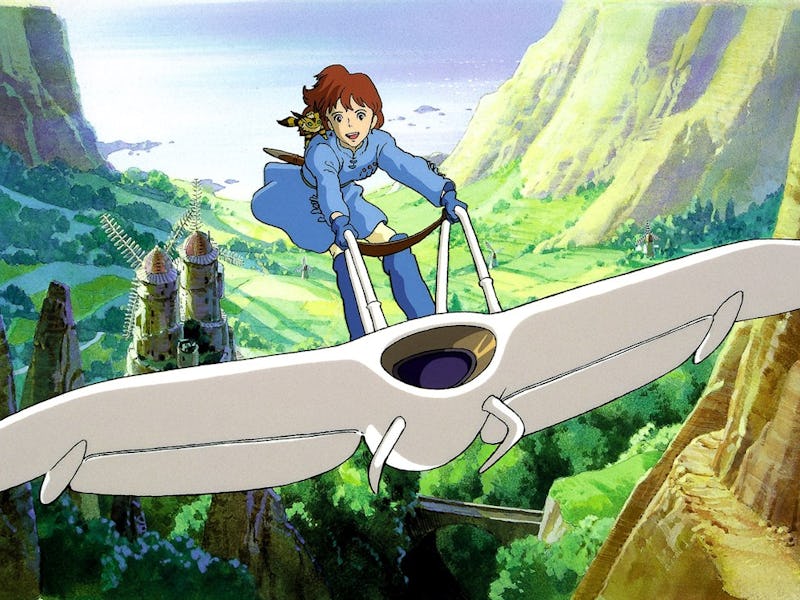Hayao Miyazaki’s Most Important Film Presents a Gentler Alternative to Dune
40 years ago, a different messiah story would capture imaginations.

In 1984, a soon-to-be-legendary filmmaker would tackle the story of a post-apocalyptic desert world where humans struggle for survival and latch their hopes on a prophecy of a messiah who will save them from extinction. Also, there are giant, deadly bugs.
That film is, of course, Hayao Miyazaki’s Nausicaa of the Valley of the Wind, the anime titan’s sweeping sci-fi film based on his 1982 manga series. But, in the year of our Lord Muad’Dib, you can’t be blamed for instead thinking of David Lynch’s Dune, the famously troubled adaptation of Frank Herbert’s sci-fi classic.
The similarities between the two stories are apparent right off the bat: both are messiah stories set on a barren planet in which humans live uncomfortably alongside hostile giant insects, which hold more importance to their worlds’ ecosystems than the characters anticipate. But while Dune tells a messier, darker, and wildly more space-LSD-addled story about the perils of prophesied heroes, Nausicaa ends on a more hopeful note.
Set in a post-apocalyptic future where a devastating conflict has reduced the Earth to barren wastelands peppered with massive toxic forests, Nausicaa follows the young warrior princess as she tries to prevent warring kingdoms from resurrecting the terrifying weapons that destroyed the world.
Nausicaa lives in the tiny oasis of the Valley of the Wind, which borders the Toxic Jungle, the poisonous forests that harbor giant, deadly insects known as the Ohmu. Simply stepping into the forests is toxic thanks to the poisonous spores in the air and the thousands of angry mutant insects, but Nausicaa has found a way to communicate with the creatures that suggests she’s the world’s long-prophesied savior.
Once you get past the surface-level similarities, Nausicaa is quite different from Dune. Miyazaki’s 1984 film is primarily an ecological sci-fi tale, while the more sociopolitical Dune takes its inspiration from the Iraq oil crisis. Nausicaa is also deeply embedded in Miyazaki’s own environmental concerns, especially in its reveal of the true purpose of the menacing Ohm.
And despite the uncharacteristically dark avenues Nausicaa goes down, like the awe-inspiring atomic-level destruction wrought by the Giant Warrior (in a sequence animated by Miyazaki protegé Hideaki Anno, a few years before he would create the seminal anime Neon Genesis Evangelion), Nausicaa is a much more optimistic story than Dune (or Miyazaki’s more cynical and complicated graphic novels). Perhaps the largest difference between the two is that Nausicaa is much more interested in what destruction humanity has wrought on the Earth than the destruction it’s wreaked upon itself.
Nausicaa would introduce the environmental concerns that Miyazaki would contend with his entire career.
But it’s interesting to see how much Nausicaa seems to draw from Dune, especially given the timing of its release alongside Lynch’s adaptation. Miyazaki has never explicitly stated that Frank Herbert’s novel served as inspiration, though other Western sci-fi classics like Ursula K. Le Guin’s Earthsea, Brian Aldiss’ Hothouse, Isaac Asimov’s Nightfall, and J. R. R. Tolkien’s The Lord of the Rings have been cited by the anime auteur. But visually, it felt even more accurate to Herbert’s vision than Lynch’s film: Miyazaki’s pulpy visuals and bug-like flying machines precede Denis Villeneuve’s take on Dune by four decades. Arguably, Miyazaki’s Nausicaa offered the most spiritually accurate take on Dune, a standard that filmmakers like Jodorowsky would try to achieve in the years that followed.
Forty years after its release, that Nausicaa is not remembered as a Dune knockoff is a testament to its importance. It was, after all, the inaugural film of Studio Ghibli, the iconic anime studio co-founded by Miyazaki that would go on to shape the animation landscape. But revisiting it in the wake of Dune: Part Two, it’s astonishing how thrilling, evocative, and equal turns hopeful and bleak Nausicaa of the Valley of the Wind is. It might not be considered Miyazaki’s best or most memorable film, but Nausicaa remains the blueprint for his incredible career and a fascinating complement to Dune.